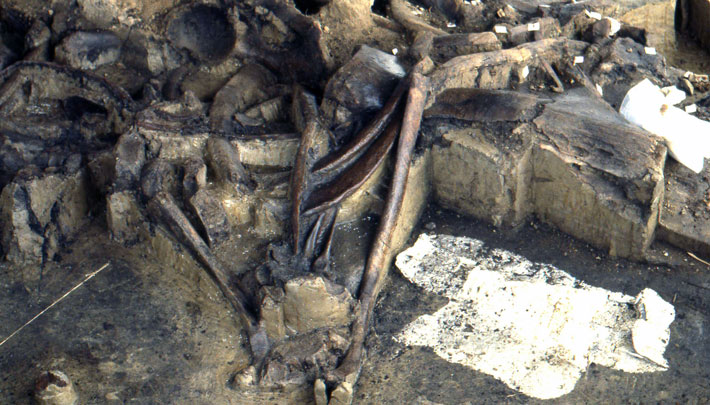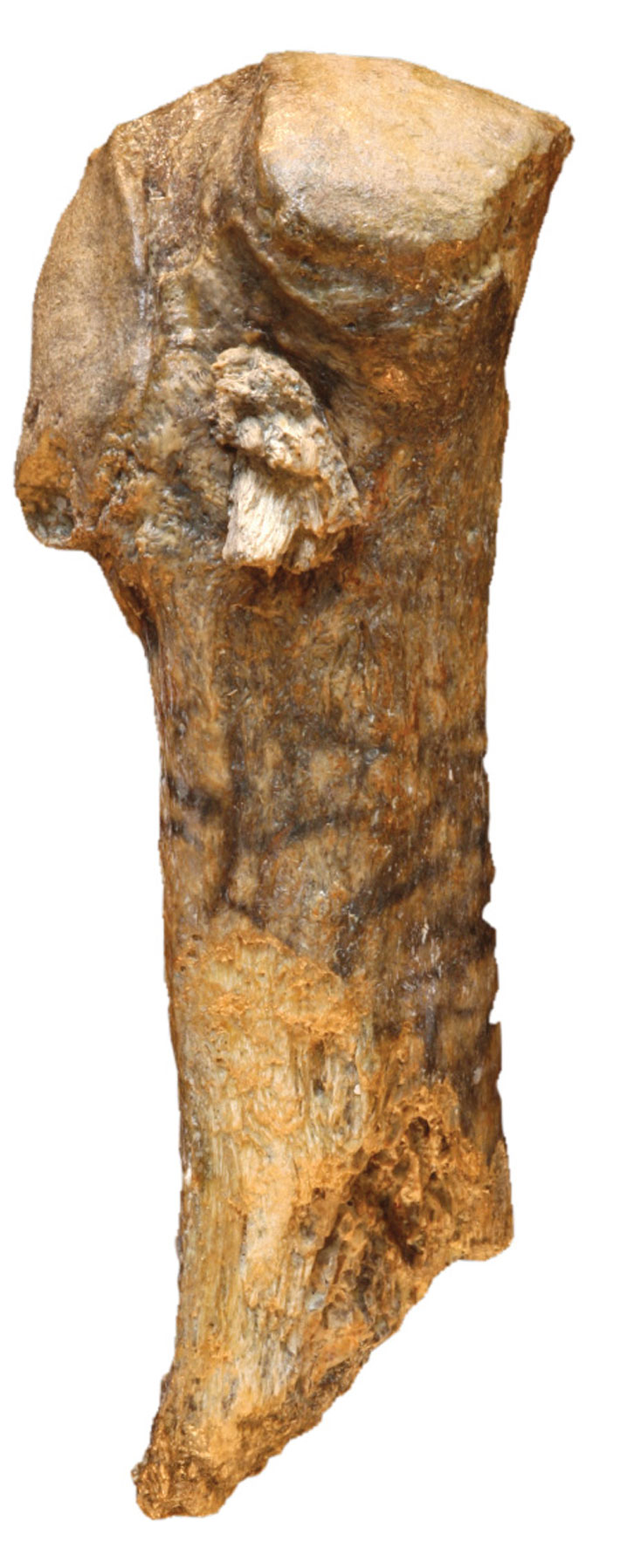First Americans
Schaefer and Hebior Kill Sites
By NIKHIL SWAMINATHAN
Monday, August 11, 2014

In 1964, while draining a marshy field on the Schaefer Farm, an hour north of Chicago, an earthmover jolted to a halt when it struck a buried mammoth femur, throwing its operator from his seat. The mammoth remains would end up in the nearby Kenosha Public Museum. More than 20 years later, an amateur archaeologist noticed cut marks on another set of mammoth bones in the museum’s collection, indicating they had been butchered. That prompted archaeologist Dan Joyce, the museum’s director, to reinvestigate the Schaefer site.
Beginning his excavations in 1992, he found, under two-and-a-half feet of ancient soils, roughly 80 percent of a completely butchered mammoth. Because the animal had been inundated by the waters of a long-dried-up lake shortly after it was butchered, its bones were well preserved. Many bore V-shaped cut marks typical of what would be made by humans using prehistoric tools. Joyce also found fragments of two stone blades with the remains. Preliminary dating says the bones are roughly 13,000 years old. “We had a Clovis date, so we thought we had a Clovis site,” Joyce says. But when the bones were redated the next year using a more sophisticated technique that purified the collagen protein in them, that assessment went out the window. The new dates came back clustered around 14,500 years ago.
If the analysis wasn’t enough to convince Joyce, what was found three-quarters of a mile away at the Hebior Farm confirmed it. There, in 1994, a team led by David Overstreet, an archaeologist at Marquette University in Milwaukee, found 90 percent of a similarly butchered mammoth, along with a more complete set of butchering tools. The bones from Hebior would be dated to 150 to 200 years before the Schaefer bones.
“Both Schaefer and Hebior are pre-Clovis, but they’re a Clovis subsistence style, so they’re almost bridging the gap,” says Joyce, referring to the Clovis people’s reputation as hunters of mammoths, bison, and other big game. “Are they more properly called ‘proto-Clovis,’ something that develops into Clovis?”
Manis Mastodon Kill Site
By NIKHIL SWAMINATHAN
Monday, August 11, 2014
 The mastodon kill site on Emanuel Manis’ property was discovered when he was digging through six feet of peat to make a small pond. Manis found two fossilized tusks that he thought had belonged to an elephant. When Washington State University archaeologist Carl Gustafson excavated the pond site in 1977, he quickly recovered one of the animal’s ribs with a bone projectile point in it. It was later determined from analysis of the animal’s tooth that the bones belonged to a mastodon.
The mastodon kill site on Emanuel Manis’ property was discovered when he was digging through six feet of peat to make a small pond. Manis found two fossilized tusks that he thought had belonged to an elephant. When Washington State University archaeologist Carl Gustafson excavated the pond site in 1977, he quickly recovered one of the animal’s ribs with a bone projectile point in it. It was later determined from analysis of the animal’s tooth that the bones belonged to a mastodon.
Organic material found near the remains was dated to roughly 14,000 years ago. Controversy ensued, with members of the archaeological community refuting the dating because it hadn’t been done on the actual bones. In addition, multiple theories emerged as to how the bone fragment had come to be embedded in the mastodon rib, including an antelope attack.
Enter Texas A&M’s Mike Waters, who, in 2011, announced that he’d dated purified collagen in the bone, and that it was 13,800 years old. CT scans and 3-D projections of the rib with the projectile in it show that the bone fragment is, in fact, a spear point. For Waters, Manis wasn’t an isolated exercise in taking a second look at forgotten sites. As a case in point, he and his former graduate student, Jesse Halligan, now at the University of Wisconsin-Lacrosse, have recently re-excavated Page-Ladson, a sinkhole on the Florida panhandle that thousands of years ago would have been above sea level. There, in the 1980s and 1990s, archaeologists discovered that ancient people likely killed a mastadon in the sinkhole. They found several flakes from stone tools and a mastodon tusk with cut marks on it. Dating nearby seeds returned ages of about 14,400 years old. But, as with the Manis find, colleagues turned a blind eye to the results. Last summer, however, Halligan found a large fragment of a biface in the same layer as the previous finds. Radiocarbon dates on twigs and seeds found around it could confirm the earlier work at the site. “My philosophy is you can reinvestigate these sites that have promise and see if they pan out,” Waters says. “Sometimes you win, sometimes you lose.”
Advertisement
Advertisement
IN THIS ISSUE
Advertisement

Recent Issues
-
 May/June 2024
May/June 2024
-
 March/April 2024
March/April 2024
-
 January/February 2024
January/February 2024
-
 November/December 2023
November/December 2023
-
 September/October 2023
September/October 2023
-
 July/August 2023
July/August 2023
-
 May/June 2023
May/June 2023
-
 March/April 2023
March/April 2023
-
 January/February 2023
January/February 2023
-
 November/December 2022
November/December 2022
-
 September/October 2022
September/October 2022
-
 July/August 2022
July/August 2022
-
 May/June 2022
May/June 2022
-
 March/April 2022
March/April 2022
-
 January/February 2022
January/February 2022
-
 November/December 2021
November/December 2021
-
 September/October 2021
September/October 2021
-
 July/August 2021
July/August 2021
-
 May/June 2021
May/June 2021
-
 March/April 2021
March/April 2021
-
 January/February 2021
January/February 2021
-
 November/December 2020
November/December 2020
-
 September/October 2020
September/October 2020
-
 July/August 2020
July/August 2020
-
 May/June 2020
May/June 2020
-
 March/April 2020
March/April 2020
-
 January/February 2020
January/February 2020
-
 November/December 2019
November/December 2019
-
 September/October 2019
September/October 2019
-
 July/August 2019
July/August 2019
-
 May/June 2019
May/June 2019
-
 March/April 2019
March/April 2019
-
 January/February 2019
January/February 2019
-
 November/December 2018
November/December 2018
-
 September/October 2018
September/October 2018
-
 July/August 2018
July/August 2018
-
 May/June 2018
May/June 2018
-
 March/April 2018
March/April 2018
-
 January/February 2018
January/February 2018
-
 November/December 2017
November/December 2017
-
 September/October 2017
September/October 2017
-
 July/August 2017
July/August 2017
-
 May/June 2017
May/June 2017
-
 March/April 2017
March/April 2017
-
 January/February 2017
January/February 2017
-
 November/December 2016
November/December 2016
-
 September/October 2016
September/October 2016
-
 July/August 2016
July/August 2016
-
 May/June 2016
May/June 2016
-
 March/April 2016
March/April 2016
-
 January/February 2016
January/February 2016
-
 November/December 2015
November/December 2015
-
 September/October 2015
September/October 2015
-
 July/August 2015
July/August 2015
-
 May/June 2015
May/June 2015
-
 March/April 2015
March/April 2015
-
 January/February 2015
January/February 2015
-
 November/December 2014
November/December 2014
-
 September/October 2014
September/October 2014
-
 July/August 2014
July/August 2014
-
 May/June 2014
May/June 2014
-
 March/April 2014
March/April 2014
-
 January/February 2014
January/February 2014
-
 November/December 2013
November/December 2013
-
 September/October 2013
September/October 2013
-
 July/August 2013
July/August 2013
-
 May/June 2013
May/June 2013
-
 March/April 2013
March/April 2013
-
 January/February 2013
January/February 2013
-
 November/December 2012
November/December 2012
-
 September/October 2012
September/October 2012
-
 July/August 2012
July/August 2012
-
 May/June 2012
May/June 2012
-
 March/April 2012
March/April 2012
-
 January/February 2012
January/February 2012
-
 November/December 2011
November/December 2011
-
 September/October 2011
September/October 2011
-
 July/August 2011
July/August 2011
-
 May/June 2011
May/June 2011
-
 March/April 2011
March/April 2011
-
 January/February 2011
January/February 2011
Advertisement






